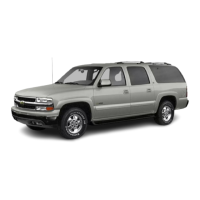
 Loading...
Loading...
Do you have a question about the Chevrolet 2002 Express Van and is the answer not in the manual?
| Brand | Chevrolet |
|---|---|
| Model | 2002 Express Van |
| Category | Automobile |
| Language | English |
Instructions on how to adjust and recline front seats, including manual and power seat options.
Guidance for adults on wearing lap-shoulder belts correctly, including driver position adjustments.
Proper safety belt usage for pregnant women, emphasizing lap belt placement.
Explanation of the air bag system, its function, and precautions for safe use.
Importance of buckling up rear seat passengers and proper lap-shoulder belt usage.
Overview of various child restraint systems like infant car beds and child seats.
Guidance on proper safety belt usage for older children who have outgrown booster seats.
Information on using a safety belt extender if the standard belt is not long enough.
Instructions for operating manual and power windows, including express-down feature.
Information about the vehicle's key, caution against leaving keys with children.
Details on locking and unlocking doors manually and with power locks.
How to use the keyless entry system for locking and unlocking.
Explanation of shift lever positions (P, R, N, D, 3, 2, 1) and their functions.
Instructions on how to set and release the parking brake.
How to adjust the steering wheel for tilt and height.
Controls for turn signals, headlamps, wipers, and cruise control.
Operation of exterior lamps including parking lamps and headlamps.
Overview of instrument panel components and their functions.
Explanation of various warning lights, gages, and indicators on the instrument panel.
How to operate the vehicle's heating, cooling, and ventilation system.
Introduction to the audio system, including radio and clock settings.
Steps to find radio stations using tuning, seeking, and preset scan features.
How to adjust bass, treble, and speaker balance/fade for optimal audio.
Instructions for playing cassette tapes, including controls and error messages.
How to insert, play, and control compact discs in the CD player.
Features of the Radio Data System (RDS) for program information and traffic alerts.
Key principles of defensive driving, emphasizing anticipation and concentration.
The dangers of drinking and driving, its effects on performance, and legal limits.
Explanation of the three main control systems: brakes, steering, and accelerator.
Understanding perception and reaction time in braking, and factors affecting stopping distance.
How the ABS system works to prevent braking skids and the meaning of the ABS warning light.
Information on power steering and steering tips for driving on curves.
Tips for safe night driving, including visibility and driver impairment.
Precautions for driving in rain, wet roads, and hydroplaning situations.
Strategies for safe driving in city environments with heavy traffic.
Advice for safe freeway driving, including merging, lane changes, and following distance.
Checklist for preparing your vehicle and yourself for a long trip.
Tips for driving in winter conditions, including vehicle preparation and driving on snow/ice.
Essential guidelines and precautions for safely towing a trailer.
Step-by-step instructions for safely jump starting a vehicle with a dead battery.
What to do if the engine overheats, including protection modes and steam warnings.
What to expect and do if a tire experiences a blowout or slow leak.
Detailed instructions on how to safely change a flat tire using the vehicle's jack.
Techniques for freeing a stuck vehicle, including 'rocking' and caution about wheel spin.
Guidance on servicing your vehicle at a GM dealer and doing your own service work.
Information on gasoline octane, specifications, and safe refueling practices.
Instructions for opening the hood and identifying key engine compartment components.
How to check engine oil level, what kind of oil to use, and oil additives.
When to check and change transmission fluid, and how to check the fluid level.
Information on DEX-COOL coolant, mixture, and safe handling practices.
Details on brake fluid, checking levels, and brake wear indicators.
Guidance on replacing various vehicle bulbs, including halogen bulbs.
Information on tire maintenance, inspection, rotation, and inflation pressure.
Tips for cleaning the interior and exterior of the vehicle, including fabric and vinyl care.
Details on maintenance services and intervals for both short trip/city and long trip/highway driving.
Owner-performed checks and services, including fluid levels and tire pressure.
Key periodic inspections recommended for vehicle safety and performance.
List of recommended fluids and lubricants for various vehicle systems.
A template to record vehicle maintenance history and services performed.
Steps to resolve customer concerns, starting with dealership management.
Contact information for TTY users to communicate with Chevrolet.
Information on the free roadside assistance program for Chevrolet owners.
Details on transportation options available during warranty repairs.
Reference to the separate warranty booklet for detailed coverage information.
How to report vehicle safety defects to NHTSA and contact information.
How to report vehicle safety defects to Transport Canada and General Motors.










